|
|
 |
TREKCORE >
VOY >
EPISODES >
SCORPION
PART I &
II >
BEHIND THE SCENES >
Designing Species 8472 Part 2
 |
|
|
|
|
|
Parts 2 and 3
of "Designing Species 8472" describe an interview Foundation
Imaging's John Teska gave to Star Trek Monthly about Species
8472. All quotes are from John Teska
unless otherwise indicated. |
|
|
|
|
|
|
 |
The task of
constructing the CGI Species 8472 creature was given to John
Teska at Foundation Imaging. He was ideally suited to the job
because, as well as being a skilled computer modeller, he has a
background in traditional creature effects such as traditional
puppets.
By the time John Teska became involved, concept artist Steve Burg
had already produced a set of drawings that showed what the creature
should look like but a lot of creative work still had to be done. In
fact, the producers handed him several drawings with instructions to
use different elements from each one.
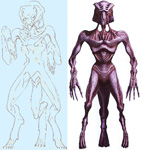 Teska
recalls, "It was something of a Frankenstein's
monster. The key features the things that distinguished the creature
were the three legs, the tendons in the neck, and the basic head
shape, all of which had been laid out in Steve's artwork. I followed
that fairly closely. But, in addition to pulling these designs
together, I had to go in and do deeper detail like sorting out the
colors and working out literally what the flesh would look like -
the wrinkles and things like that. Certainly, there was plenty of
room to put my own ideas in and breathe life into it." Teska
recalls, "It was something of a Frankenstein's
monster. The key features the things that distinguished the creature
were the three legs, the tendons in the neck, and the basic head
shape, all of which had been laid out in Steve's artwork. I followed
that fairly closely. But, in addition to pulling these designs
together, I had to go in and do deeper detail like sorting out the
colors and working out literally what the flesh would look like -
the wrinkles and things like that. Certainly, there was plenty of
room to put my own ideas in and breathe life into it." |
|
|
|
 |
John Teska
began work by setting up a very crude version of the creature in the
3D software package, Lightwave.
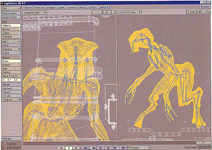 "As
there were script discussions at Paramount we started to get the
word that there would be a new nemesis that would make even the Borg
afraid. It was exciting that it would be a CG character and that it
would be a major player. When I started to get into the process I
saw some of the sketches being done by Steve Burg. I was excited
because it was non-humanoid. It didn't look like the usual guys with
facial changes. This one had this very strange neck and strange body
structure with three legs. As an animator, a designer or creature
person, I was jazzed about bringing this guy to life. In this case,
Steve Burg had several meetings with Paramount. They had different
designs of things like the arm structure. [...] There were many
drawings. They liked features on each. Paramount and Dan Curry
talked to me about the designs. They said: "Could you put them
together and make a creature?" I didn't have a singular drawing of
the final creature. There was still some evolution as he was being
sculpted in 3D. Once I had the drawings I just did a simple block
shape to figure out the proportions and the size of the head and
body, and I gave it to Paramount, so it was a back and forth thing.
It went from blocky and crude and worked up to the finer points. The
paint mattes and textures were done several weeks later. "As
there were script discussions at Paramount we started to get the
word that there would be a new nemesis that would make even the Borg
afraid. It was exciting that it would be a CG character and that it
would be a major player. When I started to get into the process I
saw some of the sketches being done by Steve Burg. I was excited
because it was non-humanoid. It didn't look like the usual guys with
facial changes. This one had this very strange neck and strange body
structure with three legs. As an animator, a designer or creature
person, I was jazzed about bringing this guy to life. In this case,
Steve Burg had several meetings with Paramount. They had different
designs of things like the arm structure. [...] There were many
drawings. They liked features on each. Paramount and Dan Curry
talked to me about the designs. They said: "Could you put them
together and make a creature?" I didn't have a singular drawing of
the final creature. There was still some evolution as he was being
sculpted in 3D. Once I had the drawings I just did a simple block
shape to figure out the proportions and the size of the head and
body, and I gave it to Paramount, so it was a back and forth thing.
It went from blocky and crude and worked up to the finer points. The
paint mattes and textures were done several weeks later.
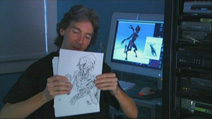 I
just started with a bunch of simple boxes and balls and laid out the
basic shape so that I could rotate it, and get a sense of whether it
had the right proportions, before I invested the time to do the
really deep modeling. It's the equivalent of a digital pipecleaner
model. You make it just to see if the creature looks right standing
next to a person - does it have the right thickness in the body, and
so on." I
just started with a bunch of simple boxes and balls and laid out the
basic shape so that I could rotate it, and get a sense of whether it
had the right proportions, before I invested the time to do the
really deep modeling. It's the equivalent of a digital pipecleaner
model. You make it just to see if the creature looks right standing
next to a person - does it have the right thickness in the body, and
so on." |
|
|
|
 |
Once he was satisfied with the basic shape, he
constructed a more sophisticated version of his model, shaping the
simple boxes and balls into limbs and muscles. The way Lightwave
works he actually gave the creature a skeleton of 'bones' that were
embedded into the virtual limbs. They were even connected to one
another by joints, which controlled the way they could move. This
skeletal system is very important to the animation process. Because
the bones are connected to one another, the animator only has to
move one of them and Lightwave calculates how the rest of the
skeleton will respond.
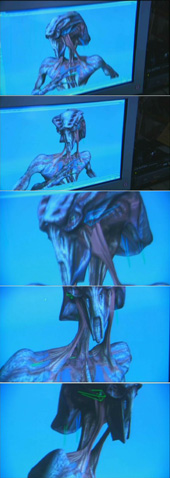 "We
animate a lot of the time with what's called inverse kinematics.
That means I'm not concerned with every single bone going down the
leg or the arm; instead I'm dealing with what are essentially
handles - little control points at the end of each arm and each leg.
Kind of like the strings you'd have on a traditional puppet. So he
evolved over the course of his creation. The software we use is
Lightwave 3D. Everything inside of it is treated like real models,
cameras and lights. Building a character like 8472, starting with
the face, I can say "I have a flat shape for the cheek", and create
polygons from the cheek, down the neck and into the body. Everything
in the mind of the computer is a shape, so it's not like I'm
drawing, like in traditional animation. In this case, I'm creating a
model, and even though it's virtual the computer looks at it like
it's a 3D object. "We
animate a lot of the time with what's called inverse kinematics.
That means I'm not concerned with every single bone going down the
leg or the arm; instead I'm dealing with what are essentially
handles - little control points at the end of each arm and each leg.
Kind of like the strings you'd have on a traditional puppet. So he
evolved over the course of his creation. The software we use is
Lightwave 3D. Everything inside of it is treated like real models,
cameras and lights. Building a character like 8472, starting with
the face, I can say "I have a flat shape for the cheek", and create
polygons from the cheek, down the neck and into the body. Everything
in the mind of the computer is a shape, so it's not like I'm
drawing, like in traditional animation. In this case, I'm creating a
model, and even though it's virtual the computer looks at it like
it's a 3D object.
There wasn't a lot of backstory, so I didn't know much about them,
but we knew that they communicated psychically, so I knew there
wasn't going to be a lot of talking. So a key thing was getting an
expressive weird forehead, and a feeling that they were different.
Knowing how they attacked - they're described as really vicious and
able to cause infection just by tearing at you - that is what drove
the animation, trying to make them feel fast and menacing. Whereas
the Borg always had numbers on their side, and had that zombie
"we're going to get you". Species 8472 is more about the surprise
that they'll burst in and start slashing. This character had a kind
of open neck structure with tendons that attach, so it became a
question of how to rig that. The same with the legs. It had three
legs, a kind of tripod structure. I thought about how this guy
walked, but we never actually saw him walk more than two steps. He's
always leaping into rooms and tearing people apart but he never just
walks down a hallway." |
|
|
|
|
|
|
 |
Once the skeletal system had been set up and he had
shaped the musculature, he had a simplistic, and very
smooth-looking, version of the creature. The next thing he had to do
was cover it in a layer of skin; this process is referred to as
'texture mapping'. Effectively, what he had to do was make a
computer-generated jumpsuit and mask for his model. When he wrapped
it around the model, Lightwave gave it textures and contours just
like real flesh. However, as he recalls, for Species 8472 this was
not a simple process.
"The texturing was
technically the most difficult part of it because there are no clear
divisions on the body. Normally, you have clothes or some other
thing to cover up the joins in the maps."
In other words, he had to create the CG skin
in different sections, just as a tailor will make a sleeve and then
connect it to the back and the front of a jacket. However, when you
make a suit no one complains that you can see the seams. Species
8472 was to be naked and thus there could be no explanation for any
obvious joins. The creature was designed several years ago, when CGI
(computer-generated image) technology was much more primitive than
today.
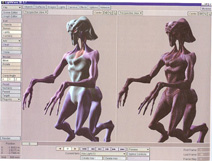 "This
was early on in the evolution of Lightwave, so the choices we had
for texture mapping were somewhat limited. At the time there was
really only one good 3D paint program on the market. That really
saved my butt. It was just a matter of dividing the maps into all
these different pieces, so the arms are painted more or less from
the side, the head is more or less painted like a ball, the body is
treated like a cylinder. Then I had to come back in with additional
paint maps and do a lot of blending between all these different
zones. That was definitely the biggest challenge. What I wouldn't
have given for this guy to wear a T-shirt!" "This
was early on in the evolution of Lightwave, so the choices we had
for texture mapping were somewhat limited. At the time there was
really only one good 3D paint program on the market. That really
saved my butt. It was just a matter of dividing the maps into all
these different pieces, so the arms are painted more or less from
the side, the head is more or less painted like a ball, the body is
treated like a cylinder. Then I had to come back in with additional
paint maps and do a lot of blending between all these different
zones. That was definitely the biggest challenge. What I wouldn't
have given for this guy to wear a T-shirt!"
The image above shows what the creature looks like with and without
its texture maps. The model itself is relatively smooth, though many
of the larger shapes, such as the bumps on the head, are built in.
Most of the details, such as the wrinkles in the flesh, are actually
in the texture maps that are used for the skin and are wrapped
around the model as if they were clothes. |
|
|
|
|
|
|
|
|
<
Part 1 |
Index |
Part 3 > |
|
|


|
|



